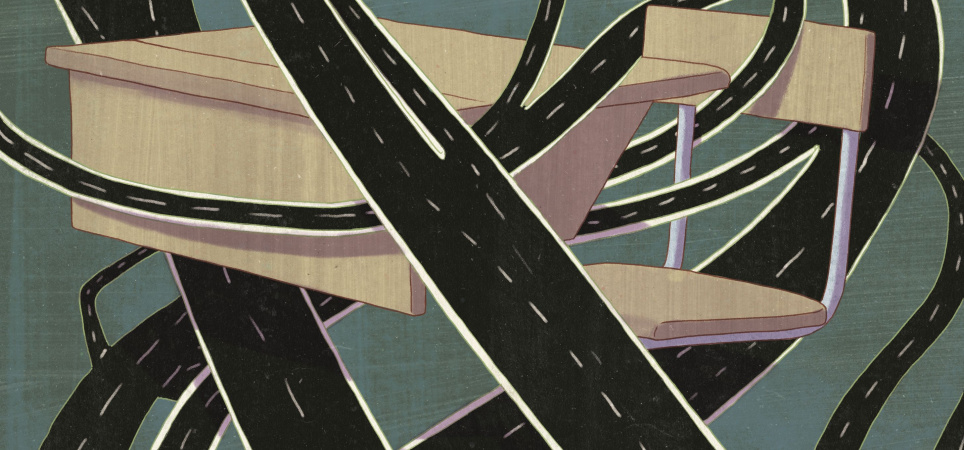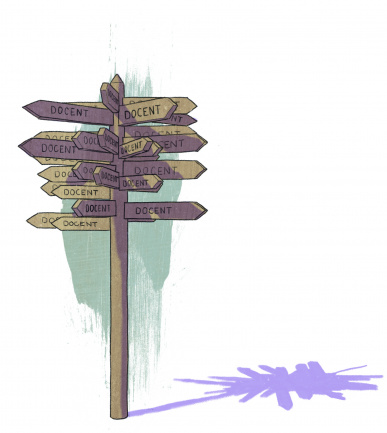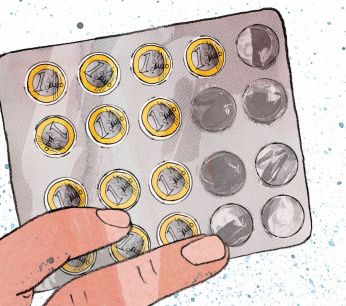The 386 Paths to Teaching
Due to the teacher shortage, there are more and more opportunities to obtain a teaching certificate more quickly. What does this do to the quality of education?

Image: XF\x26amp;M
A new teaching module is coming, the educational module, based on the educational minor. Students with a university bachelor's degree can obtain a stripped-down second-degree certificate in six months.
Patchwork
“No”, teacher trainer Wim Borghuis shouts in protest. “Not another new module.” Borghuis has been teaching the class for thirty years and, in addition to being a teacher educator at the Hogeschool Utrecht, he is also chairman of the AOb- network training of teachers and member of the higher professional education sector council. “Do you know how many routes there are already to become a teacher?” A short silence falls. “385 trails. For all sectors. Now the educational module is added. Then we come to 386.” His biggest objection? “All those routes are not the result of well-considered government policy, but are a response to a shortage of teachers. It's patchwork.”
All these routes are a response to the teacher shortage. It's patchwork
It cannot be otherwise, Borghuis believes, that with so many different routes, the quality of the teaching profession is not guaranteed. “There is no overview of everything that is offered in terms of training, shortened courses and modules. You cannot work on a standard for authorizations without an overview. My impression is that with all those training variants, the bar is not adjusted upwards, but usually downwards, as a result of which the profession of teacher is thrown away.”
The box is thrown to the grab
Appreciation
Carla Haelermans, professor of educational economics at Maastricht University, shares the concerns about the quality of education. “Teaching is an extremely important profession,” she says. “But by offering all those abbreviated courses, it feels like anyone can become a teacher with a few modules.” According to her, the appreciation that we as a society attach to the teaching profession is related to quality. “We should not want to send out the signal that everyone can become that for a while. It is not very realistic, you cannot master the skills of teaching in six months.”
It feels like anyone can become a teacher with a few modules
For some time now, studies have shown that the level of education in the Netherlands is falling compared to the countries around us. According to the Education Inspectorate, student achievement has gradually declined over the past twenty years. In recent years, the Inspectorate has also seen an increasing number of primary school pupils who cannot read well.
This article is from the March Education Magazine. Do you want to stay informed about everything that is going on in education? Join the AOb and receive the Education magazine every month.
Check out all the benefits of membership
“Actually you want to make a quality improvement”, says Haelermans. “Soon you will have enough teachers, but the quality will drop even further. You don't want that.” According to the professor, politicians should decide how we want to see the teaching profession. “The teacher has to deal with so many other tasks and things, but you can only spend your time once and that should be with teaching. Let teachers do what they are good at.”
Side entrants
In the scattered landscape of 386 learning routes to become a teacher, Stefan Kruithof chose the shortened module of lateral entrant. Professor Haelermans believes that lateral transfer students with a lot of work and life experience can be a good way to become a good teacher. Kruithof (35) is such a teacher with a lot of experience. He teaches ten years of history at the Marnix Gymnasium in Rotterdam, a small categorical gymnasium. When we speak to him, a few students are standing at his table to schedule a catch-up test. He entered education as a homework tutor, at the time a part-time job alongside his studies in philosophy and archaeology. Pretty soon the school asked him if he would like to give social classes. And it has stuck ever since. Without authority. In the meantime, the umbrella school organization is hot on his heels. “Of course I also want to obtain the authorization myself, I think that the paper must be in order, but I don't like the training. If I hadn't been able to follow a shortened course, I don't know if I would still be in education.”
If I hadn't been able to follow a shortened course, I don't know if I would still be in education today
The lateral entry program that Kruihof followed - he just finished - was completely tailored to obtain his second-degree qualification in one year. 35 credits, which means half a year of study for a full-time student. Kruithof did it alongside his job as a history teacher. Before he was exempted from many of the subjects, he completed an assessment, which included video recordings of lessons, testimonials from colleagues, student surveys, lesson plans and class visits. He had broken off a previous teacher training course to work for the army. “The bar was set quite high in the assessment,” he says. “I think that's a good way to guarantee the quality of teachers. I had to prove myself in the same way in that short course as in a long course.”
Veerle Swart (26) discovered that a solid four-year study is perhaps the best way forward. She is studying to become a social science teacher. She comes from the hairdressing profession, worked in a salon, but felt that she earned too little. She is also a good learner and she decided to train hairdressers. “I had registered for a short variant, but then I heard someone say that it is better to do your bachelor's degree, because there are many schools that no longer hire anyone with a shortened track. Then I just wanted to do it right.”

Image: XF&M
She finds the study super fun, even though it is hard work in addition to a 32-hour job as a teacher. She got that job in the third year of the training. “It's tough, I don't have a minute to myself. Sometimes when I'm at work, I'm thinking about what I need to do for my studies and vice versa.”
Was she ready to teach in that third year? Not really, she says, “but I thought: I have to”. The hairdressers were closed due to the pandemic, so she bet on teaching. “I was lucky with a nice workplace and with good guidance, I can sometimes make a mistake.” And, she says: “I naturally learn a lot more in four years than someone who does a shortened course. A colleague previously did a shortened trajectory and now has to obtain a second-degree qualification from school. So that's a bit of a double-up."
Heavy
Once a student has chosen one or another module or course to become a teacher, it is by no means certain whether he will complete the course. Teacher trainer Borghuis sees that the dropout rate is high. “Students don't last, they often drop out during their studies or else early in their work.” Students who are good often find a job through their internship in the second or third year. For example, they are first given 4 hours of history and then the supervisor asks: We have a problem with Mr. Jansen, can you add another two hours of geography? And could you also take over the mentorship? “And then the teacher has two feet in the field and the study falls by the wayside,” says Borghuis. “At a certain point, things start to get tricky, because a diploma has to be obtained after all. First the manager is happy because a gap has been closed and then the manager becomes a difficult one because now he wants to see a diploma.”
In October last year, research agency Berenschot published a report on the reasons for students dropping out. Students in a second-degree teacher training program often drop out above average. The report states: 'Although the intake of teacher training courses has increased over the past three years, this will not solve anything if students subsequently do not complete the training. It's time for the next step: increasing study success.'
The report concludes that teacher training is perceived by students as relatively difficult compared to the average higher professional education programme. Students are expected to show a certain degree of professional maturity and maturation early on. In addition, according to the report, students within programs with shortages are regularly assigned more responsibility during their internship than they are ready for based on the regular training pace. See also the story of Veerle Swart.
Students are expected to have professional maturity and professional maturation at an early stage
Also policy advisor Marieke Jansma van de AOb sees a major problem in the many training routes and the fact that so many routes have been devised to help people obtain a qualification as quickly as possible. “It has also already been shown that the educational module is far too lean and does not lead to a full-fledged teaching position.”
What bothers teacher educator Wim Borghuis about this is that many of the new laws, such as those of the educational module, have not been discussed with teachers and the profession. “That is why it never produces good results.” He saw this earlier with the Act on Side Entry and the Flexibility Act. “As teachers, we have outsourced too much. There is a huge gap in education policy between policy makers and implementers.”
You can read this article for free from the March Education Magazine. News, backgrounds and tips in your mailbox every month? Word AObmember!


